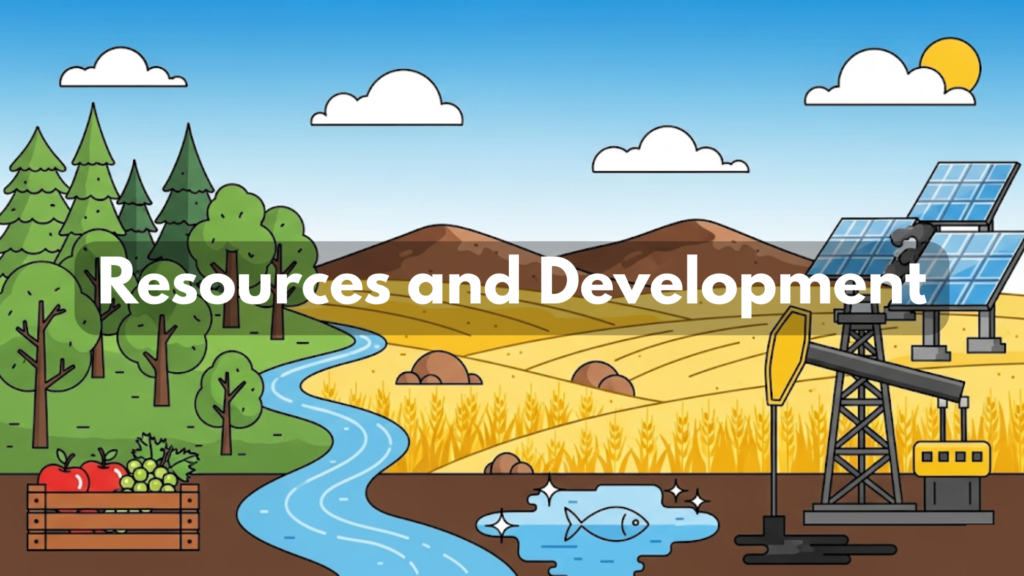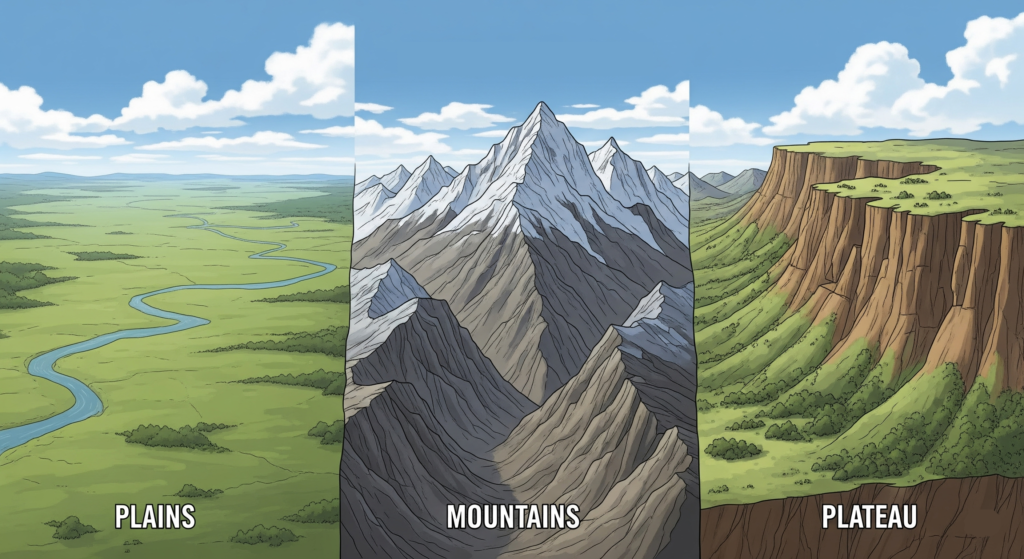Here are the comprehensive Resources and Development Notes, based primarily on the NCERT textbook for the CBSE Class 10 Geography syllabus, Chapter 1. These notes cover all key concepts of the chapter, including the classification of resources, sustainable development, resource planning in India, types of soil, land use patterns, and methods of soil conservation. Designed to help you understand and remember each topic clearly, the notes include simplified explanations, categorized information, real-world examples, and essential definitions. Whether you are revising for exams or building a strong foundation in geography, this chapter summary is your quick and reliable guide.

Introduction to Resources
A resource is anything in our environment that can be used to satisfy our needs, provided it’s technologically accessible, economically feasible, and culturally acceptable. Resources are a result of human activities, and people are essential components of resources themselves. Humans interact with nature using technology and create institutions to speed up their economic development, forming an interdependent relationship between nature, technology, and institutions.
Classification of Resources
Resources can be classified in the following ways:
- Based on Origin: Biotic and abiotic.
- Based on Exhaustibility: Renewable and non-renewable. Renewable resources include continuous or flow resources like wind and water, and biological resources like natural vegetation and wildlife. Non-renewable resources can be recyclable (e.g., metals) or non-recyclable (e.g., fossil fuels).
- Based on Ownership: Individual, community, national, and international.
- Based on Status of Development: Potential, developed, stock, and reserves.
Development of Resources
Resources are crucial for human survival and for maintaining a good quality of life. The belief that resources are “free gifts of nature” has led to their indiscriminate use, causing significant problems like:
- Depletion of resources to satisfy the greed of a few individuals.
- Accumulation of resources in a few hands, which has divided society into the “haves” and “have-nots” (rich and poor).
- Global ecological crises such as global warming, ozone layer depletion, environmental pollution, and land degradation.
To address these issues and ensure a sustained quality of life and global peace, an equitable distribution of resources is essential.
Sustainable Development
Sustainable development means that development should occur without harming the environment, and present development should not compromise the needs of future generations.
- Rio de Janeiro Earth Summit, 1992: Over 100 heads of state met in Brazil to address environmental protection and socio-economic development globally. They signed the Declaration on Global Climatic Change and Biological Diversity and adopted Agenda 21.
- Agenda 21: This declaration, signed at the United Nations Conference on Environment and Development (UNCED), aims to achieve global sustainable development by combating environmental damage, poverty, and disease through global cooperation. A key objective is for every local government to create its own local Agenda 21.
Resource Planning
Planning is a widely accepted strategy for the judicious use of resources, which is especially important in a country like India due to its vast diversity in resource availability. Some regions in India are rich in certain resources but lack others. For example:
- Jharkhand, Chhattisgarh, and Madhya Pradesh are rich in minerals and coal.
- Arunachal Pradesh has abundant water but lacks infrastructure.
- Rajasthan is rich in solar and wind energy but lacks water.
- Ladakh has a rich cultural heritage but is deficient in water, infrastructure, and vital minerals.
This highlights the need for balanced resource planning at all levels.
Resource Planning in India
The process of resource planning in India involves three main steps:
- Identification and inventory of resources through surveying, mapping, and quantitative and qualitative estimation.
- Developing a planning structure with appropriate technology, skills, and institutional setups to implement development plans.
- Matching resource development plans with overall national development plans.
Resource availability alone doesn’t guarantee development; it must be accompanied by appropriate technological development and institutional changes. The history of colonization shows that a higher level of technology helped colonizing countries exploit resources and establish their supremacy.
Conservation of Resources
Resource conservation is vital to overcome the socio-economic and environmental problems caused by irrational consumption and over-utilization.
- Gandhiji’s Philosophy: He stated, “There is enough for everybody’s need and not for anybody’s greed,” and identified greedy individuals and modern technology’s exploitative nature as the root cause of resource depletion. He favored production by the masses over mass production.
- International Efforts: The Club of Rome first advocated for systematic resource conservation in 1968. The Brundtland Commission Report, 1987, formally introduced the concept of ‘Sustainable Development’ as a means for conservation. This was followed by the Earth Summit in Rio de Janeiro in 1992.
Land Resources
Land is a crucial natural resource that supports all human activities, including agriculture, industry, and infrastructure. As land is a finite asset, it must be used with careful planning.
Land Relief Features in India

India’s land is characterized by various relief features.
- Plains: Cover about 43% of the total land area, providing suitable land for agriculture and industry.
- Mountains: Account for 30% of the area and provide perennial river flows, tourism opportunities, and ecological benefits.
- Plateaus: Make up about 27% of the area and hold rich reserves of minerals, fossil fuels, and forests.
Land Utilization in India
Land resources in India are used for various purposes:
- Forests.
- Land not available for cultivation, which includes barren and waste land, and land used for non-agricultural purposes like buildings and roads.
- Other uncultivated land, excluding fallow land (e.g., permanent pastures, land under tree crops, and culturable wasteland).
- Fallow lands, which are either left uncultivated for one or less than one agricultural year (current fallow) or for 1 to 5 agricultural years (other than current fallow).
- Net sown area, which is the physical extent of land where crops are sown and harvested. The gross cropped area includes the area sown more than once in an agricultural year.
Land Use Pattern in India
The use of land is influenced by physical factors like topography, climate, and soil types, as well as human factors like population density, technology, and culture. The total geographical area of India is
3.28 million sq km. However, land use data is available for only 93% of the total area due to incomplete reporting from some northeastern states and unsurveyed areas in Jammu and Kashmir.
The forest area in the country is significantly lower than the desired 33% outlined in the National Forest Policy (1952), which is essential for maintaining ecological balance.
Land Degradation and Conservation
Land degradation is the continuous use of land without proper conservation and management, leading to a decline in its quality. This has serious repercussions on society and the environment.
Causes of Land Degradation
- Human activities such as deforestation, overgrazing, mining, and quarrying are major contributors.
- In states like Jharkhand, Chhattisgarh, Madhya Pradesh, and Odisha, deforestation from mining is a primary cause.
- Overgrazing is a main reason in Gujarat, Rajasthan, Madhya Pradesh, and Maharashtra.
- Over-irrigation in states like Punjab, Haryana, and western Uttar Pradesh leads to waterlogging, increasing soil salinity and alkalinity.
- Mineral processing (e.g., grinding limestone for cement) releases a large amount of dust into the atmosphere, which settles on the land and hinders water infiltration.
- Industrial effluents and waste have become a major source of land and water pollution.
Conservation Measures
Various methods can be used to solve land degradation problems:
- Afforestation and proper management of grazing.
- Planting shelter belts and stabilizing sand dunes with thorny bushes in arid areas.
- Proper management of wastelands, control of mining activities, and treating industrial effluents before discharge.
Soil as a Resource

Soil is a vital renewable natural resource that supports plant growth and various living organisms. It is a living system that takes millions of years to form just a few centimeters deep.
- Factors of Soil Formation: Relief, parent rock, climate, vegetation, other life forms, and time are the most important factors. Changes in temperature, the actions of running water, wind, and glaciers, and the activities of decomposers also contribute to soil formation.
Classification of Soils
India’s diverse relief, landforms, and climate have resulted in various soil types.
- Alluvial Soils: The most widespread and important soil, making up the entire northern plains and deltas of the Mahanadi, Godavari, Krishna, and Kaveri rivers. They are very fertile, rich in potash, phosphoric acid, and lime, making them ideal for crops like sugarcane, paddy, and wheat. Alluvial soils are classified by age as Bangar (old alluvial) and Khadar (new alluvial). Bangar has more
kankernodules, while Khadar is finer and more fertile. - Black Soils: Also known as regur soils, they are black and ideal for growing cotton. They are typical of the Deccan trap region, covering parts of Maharashtra, Saurashtra, Malwa, Madhya Pradesh, and Chhattisgarh. Black soils are made of extremely fine clayey material and are known for their ability to hold moisture.
- Red and Yellow Soils: Develop on crystalline igneous rocks in low rainfall areas of the Deccan plateau, Odisha, Chhattisgarh, and the middle Ganga plain. They get their reddish color from the diffusion of iron in metamorphic and crystalline rocks and appear yellow when hydrated.
- Laterite Soils: Derived from the Latin word
later, meaning “brick”. They develop under tropical and subtropical climates with alternating wet and dry seasons and are the result of intense leaching from heavy rain. These soils are generally acidic and deficient in plant nutrients. In hilly areas of Karnataka, Kerala, and Tamil Nadu, they are useful for growing tea, coffee, and cashew nuts. - Arid Soils: Range from red to brown, are sandy and saline, and are found in dry climates. They lack humus and moisture, and the lower horizons contain
Kankarlayers that restrict water infiltration. With proper irrigation, these soils can become cultivable, as seen in western Rajasthan. - Forest Soils: Found in hilly and mountainous areas with sufficient rain forests. The texture varies, being loamy and silty on valley sides but coarse-grained on upper slopes. These soils are acidic and have low humus content in snow-covered areas of the Himalayas.
Soil Erosion and Conservation
Soil erosion is the removal and washing away of the soil cover. While soil formation and erosion usually happen simultaneously, human activities like deforestation, overgrazing, and mining can disturb this balance.
Types of Soil Erosion
- Gully Erosion: Running water cuts deep channels into clayey soils, making the land unfit for cultivation, creating “bad land”.
- Sheet Erosion: Water flows as a sheet over large areas, washing away the topsoil.
- Wind Erosion: Wind blows away loose soil from flat or sloping land.
- Defective Farming Methods: Ploughing up and down a slope creates channels for water flow, leading to erosion.
Soil Conservation Measures
- Contour Ploughing: Ploughing along contour lines to slow down the flow of water.
- Terrace Cultivation: Cutting steps on slopes to restrict erosion; this is common in the Western and Central Himalayas.
- Strip Cropping: Dividing large fields into strips and leaving strips of grass to grow between crops to break the force of the wind.
- Shelter Belts: Planting rows of trees to create shelter, which helps stabilize sand dunes and the desert in western India.






